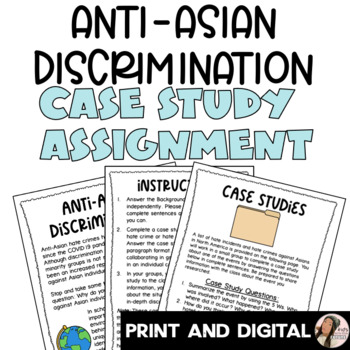Asian American & Pacific Islander (AAPI) Heritage Month NO PREP ELA Case Study
- Zip
Also included in
- Don't be afraid to teach your class about anti-racism and anti-Asian discrimination during Asian Pacific American Heritage Month! This bundle resource helps you to meaningfully address social justice in your classroom. I am Canadian and I’m of Chinese and Vietnamese descent. Stop AAPI Hate is a topiPrice $4.50Original Price $5.50Save $1.00
Description
Unsure about how to teach your class about anti-racism and anti-Asian discrimination? This resource helps you to meaningfully address social justice in your classroom. I am Canadian and I’m of Chinese and Vietnamese descent. Stop AAPI Hate is a topic I am passionate about and it needs to be discussed. Use this assignment to educate your class about the historical context of racism against Asian individuals and to complete case studies (in pairs or in small groups) about recent hate-related events in North America. Your students will be motivated to learn about this topic with real-world connections.
This no prep lesson teaches students about stereotypes, the difference between a hate incident and a hate crime, and the importance of being aware of the impact and consequences of racist behaviour.
✨This product includes✨
- Student Assignment Handout with background information questions (Chinese Immigration Act, War Measures Act, model minority) and engaging case study topics (with critical thinking questions) about recent anti-Asian incidents and crimes
- Google Docs™ version of the assignment questions (with boxes for students to type in)
- Teacher answer guide
- Detailed teacher instructions about how to teach the lesson
- BONUS: assignment extension ideas
This resource is suitable for distance learning (ready for Google Classroom™) and in-person learning. You can also print the Doc and/or PDF file to provide hard copies for your classroom.
This assignment will take at least three classes to complete and throughout, whole class discussions will promote the importance of inclusion and preventing racist attitudes and situations from happening.
✨THIS RESOURCE IS PART OF A BUNDLE✨
TEACHER FEEDBACK:
"This resource was very sensitive and well created! It was also very timely for my students to complete with events that were happening in the community."
"Thank you for helping me address important topics in my classroom! Will be using this again!"
"The kids learned alot and I loved that I could do this in breakout rooms"
RELATED BLOG POST:
OTHER POPULAR ENGLISH LANGUAGE ARTS RESOURCES:
- End of the Year Activities: Positive English Language Arts Lessons Bundle | SEL
- Wellbeing and Growth Mindset Journal | Distance and In-Person Learning | 50 EDITABLE Prompts
- End of the Year Some Good News Media Literacy & Writing Assignment | Distance Learning (1 Week)
Join my email list for freebies and visit my blog for teaching inspiration and updates.
Connect With Me:
How do I earn TPT credits to save money on my future purchases?
Click on My Purchases and beside each product, you can view whether you have left feedback about a product. Click on Leave a Review underneath the product title and seller.
Please leave a review if you can, I would really appreciate it. Follow me for future products, updates, and sales!
© Kids are the Future






